Reprinted from The Valve, back in July of 2008.
I suppose I was somewhere between 11 and 13 years old when I saw Young Man With a Horn on TV. It had a powerful effect on me. I played trumpet, not terribly well in any absolute sense, though I was pretty good for my age. And I was discovering jazz.
A movie about was a jazz trumpet player was thus a natural. The actual trumpet playing was superb, as it was done by Harry James – a man who knew the craft, though I didn’t know it at the time. The film starred Kirk Douglas as Rick Martin and told a standard tale of conflict between the requirements of commercial success and the need for artistic freedom. It also told a standard tale of a man caught between a mysterious woman who’s no good for him and the wholesome woman who’s just what he needs, though he doesn’t find that out until he’s all but destroyed himself pursuing the mystery woman.
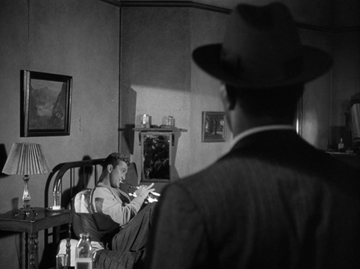
But this essay is mostly about the music, not the romance. And about the racial characterization, not only of the music, but, by implication, of one’s soul, one’s inner self. But let’s hold off on that for a moment while I continue to wax nostalgic.
There’s a scene early in the film where Rick Martin is sitting in bed playing his trumpet while his teacher looks on. I thought this was so cool that, as soon as the movie was over, I went up to my room, sat in my bed, and played my trumpet. That’s the kind of effect this movie had on me. But I soon discovered that, cool though it may have looked, sitting in bed is no way to play the trumpet. It makes breathing and breath support difficult. Without breath, the trumpet is nothing. I also learned to be skeptical about what you see in movies.
End of digression. This is not about what I learned from this movie when I was a kid. This is about how the movie staged the social relations of jazz.
* * * * *
Young Man with a Horn came out in 1950, and seems to have been set in that time period, though the music it features is a little old to pass for cutting edge at the time. (Bebop is what was happening n 1950.) Rick Martin is an orphan living with his aunt in Los Angeles; she’s more interested in going out on dates than in taking care of her young nephew. It is strongly implied that she’s a loose woman.
One day during Christmas season, young Rick is wandering around and hears singing in the mission house. He stands at the back listening and, when the men go to get their free meal (for which they dutifully sang), Rick goes up to the piano and starts pounding away. Eventually he manages to play “Come All Ye Faithful.” He’s discovered his vocation in church. Not in the run of ordinary secular living, but in a church, albeit a church dedicated to serving the indigent.
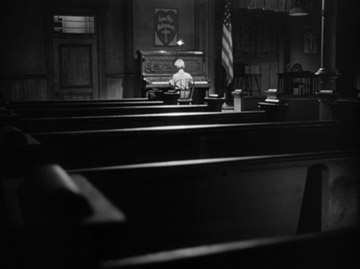
But Rick’s not yet discovered jazz. That happens one day when he’s working as a pin-setter at a bowling alley. He hears jazz coming from somewhere outside. When work is over, he goes looking for the music and finds a jazz club. He climbs up into the transom and looks through the window, where he sees a jazz band playing for dancers. The musicians are black, the dancers are white.

That’s what this essay is about, how the film stages the interaction between black people, white people, and jazz. We have a motherless young white boy, who likes music, on the outside looking in.
Rick stays in the transom, transfixed, until the evening is over. The customers leave, the staff (all black) is cleaning up, and the musicians are relaxing after the gig. Art Hazzard (Juano Hernandez), the trumpet-playing leader, spots him up there in the transom and invites him in. They hit it off and Mr. Hazzard agrees to teach Rick the ways of the trumpet.
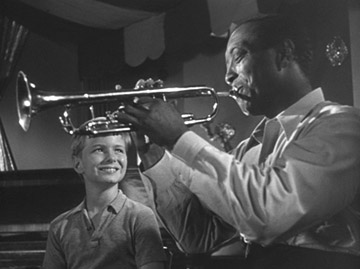
Rick, of course, is delighted, and he learns well. (Just what his aunt is doing all this time is something of a mystery.) In time, Art informs Rick that he’s gotten the call to go back East and play in an important New York club. He can’t turn the gig down. Rick is crushed.
But he survives and hooks up with a big band; all the musicians are white. There he meets Smoke, a piano player (jazz pianist and composer Hoagy Carmichael), and Jo Jordan, a singer played by Doris Day. (She’s the good woman; he’s with her at the end of the film, but it was tough getting there.) He wants to blow hot solos, the leader wants him to play what’s written. This is a standard conflict, commerce (what's written) vs. art (hot solos). Things don’t work out.
Rick and Smoke travel from gig to gig and eventually make their way to New York. Rick’s now got something of a reputation and is thus able to get a gig with a top band. But it’s Jo Jordan who gets him the gig; she’s the singer with the band. All the musicians in the band are white, as is the clientele of the club where it plays. Commerce.
Then Rick discovers that Art’s playing in a club down in the Village and goes to hear him. The club’s a very swanky joint. The patrons are all white, naturally. But Art’s band is black, just as natural. We’ve been here before. Rick sits in with his old teacher and they tear it up. He’s home. Art.
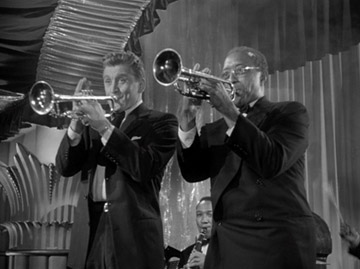
He falls into a routine: He makes his money as a star playing the notes with the white band. He feeds his soul playing real jazz with Art and the boys, but in front of a white audience. Somewhere along the line life gets complicated. He meets Amy (Lauren Bacall), a friend of Jo’s. Amy’s an intellectual, studying psychoanalysis. He marries her; it’s no good. He becomes an alcoholic.
While Rick's on the way down, Art Hazzard visits him in a bar and they have a heart-to-heart talk. Rick’s drinking whiskey. Art’s drinking milk—at the bar, at the bar! Mother’s milk? Who knows, but the movie makes a big deal out of that milk—is that the same milk, symbolically speaking, that Rick offered Art years ago when Art left California? The conversation deteriorates and Art leaves the bar. Both men are upset.
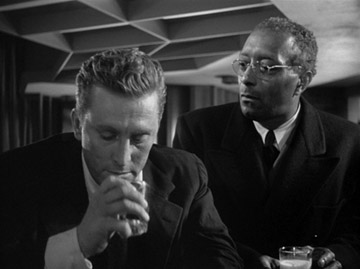
Art gets struck by a car right after he leaves the bar and is killed. Rick doesn’t find out until a couple of days later when he finds out about the funeral. Drunken sot that he is, he knows, nonetheless, that he has to attend the funeral.
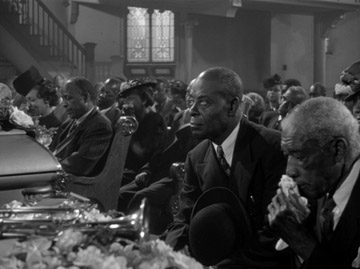
And he does. The service is in a church, a church with black people in the pews, and only black people. This is the first time in the movie we’ve seen a room filled with black people. This is the first and only time the movie has taken us into black society. That the occasion should be a religious service, that’s most interesting. For it echoes the context in which young Rick discovered his love of music.
There’s a eulogy, some singing, and then Rick picks up Art’s trumpet from its spot on the lid of Art’s casket. He blows a beautiful solo. Naturally, soulfully.
The movie’s not over. Rick still has to hit bottom. Which he does. Smoke finds him; Jo finds him. He finds himself and, of course, the good woman. As the movie rolls to a close Jo and Rick are doing a duet; but that duet really features the trumpet player.
End of film.
Now, let’s review. This is a film in which a white man finds his vocation, and his music, though black music. That is clear. It is also clear that there is a strong bond between Rick Martin and Art Hazzard. That bond, however, is isolated from all of Rick’s other social ties. The question of just what kind of life Hazzard has off the bandstand does not come up. Nor does the movie show any interaction between blacks and whites outside of a musical context and, for that matter, very little within that context. The only reason Martin went into that black church was so he could pay his respects to the man who had been like a father to him. The church, of course, is set apart from mundane life. In this movie, that functional segregation mirrors pervasive and unstated racial segregation. As a public person, Rick Martin lived in a white world. The fact that Rick Martin finds himself and his vocation through a black man is utterly without wider social consequences.
By the time Young Man With a Horn was made, 1950, jazz had ceased to be the popular music it was when young Mickey Rooney and his friends decided to start a band. Big bands—where Rick Martin made his money—were still around, but not like they were in 1930 or 1940. Small groups playing in a traditional style, like Art Hazzard’s band, would spark a college-centered Dixieland revival. The music in this film was on its way to the museum and to the old folks home. It was easy to take the social dichotomy between black and white and map it onto the dichotomy between private and public in such a way that black culture expressed the private inner life of a white protagonist and black people have no significant public existence.
Mickey Rooney formed a band so he could take part in the adult world. Rick Martin turned to True Jazz so he could remove himself from an adult world identified with commerce. And True Jazz became Other People’s Music, precisely because those other people could be denied full participation in that public world.
* * * * *
Addendum, From a comment I made in the discussion at The Valve: Note that, though it was made well into the color era, Young Man was shot in black and white, which was not uncommon at the time. I’m not familiar enough with films of that era to have a sure sense of what that signifies, but I’m guessing they were going for a sophisticated “arty” look. It’s got a very noirish feel, a lot of urban grit. I don’t think Young Man was made for a teen audience at all. It was made for adults. The sexual dynamics, which I didn’t go into at all, are certainly more sophisticated than you find in the Elvis films, for example, or the big-band biopics. Lauren Bacall plays a sophisticated urban woman who is studying to be a psychoanalyst and even dispenses a little of the lingo, as I recall. There’s also a suggestion that she’s a lesbian or bisexual. Just why she married Rick Martin is something of a mystery.
This Warner Bros bio-pic is certainly a cut above the average of its type and year. Dorothy Bakers searing novel is adapted for the screen by Carl Forman (High Noon) and Edmund H. North (Patton). Versatile Kirk Douglas again confirms his tour de force range of emotions as a young Trumpet player (Rick Martin) on the way up and also on the skids. He’s also in love with the wrong woman! Sultry Lauren Bacall is perfect as the wrong ‘female’ - a slinky rich psychiatry student and destructive gender confused type - who dabbles in everything and is generally unsuccessful at them all. Doris Day giving a semi-dramatic turn does very well as the dance band singer who warms to the ‘lost’ trumpeter.
ReplyDeleteDouglas brings pathos, and power to his character (loosely based on the life of Bix Beiderbecke) especially during the breakdown scenes – but he’s perhaps a tad overconfident a performer to fully convince as a clumsy, low self esteem type (this could also be partly due to Curtiz’s direction) Juano Hernandez gives a standout performance as the sympathetic jazz muso who takes the young orphan under his wing – freely giving him vital tuition that guarantees the naturally talented, but disadvantaged lad - a priceless introduction to a career in the field of professional music.
Michael Curtiz delivers his usual confident directorial professionalism but perhaps the real power is found in the dazzling look of this film. Superb director of photography Ted McCord fills every scene with his strong stylised visuals – injecting a moody power into every situation, also making the grand cast look especially magnificent. Best of all, is his stunning use of outdoor locations, featuring richly dramatic shots of parts of N.Y. that has since passed into memory. Not enough can be said of the power this combination of McCord and Curtiz bring to this un-miss-able 1950 picture!
Striking musical direction and score by Ray Heindorf, with a shamefully uncredited additional score by the great Max Steiner - featuring the playing of trumpet virtuoso’s Harry James and Jimmy Zito, make for an unforgettable dramatic musical treat. Great production values, art direction, sets, editing, wrap together an eye-popping, ear candy experience for lovers of the era. The upbeat ending could have been dropped but is not as bad as some may say within a ‘loosely’ based bio. Hoagy Carmichael is unforgettable as piano player/narrator ‘Smoke’ ~ with young Orley Lindgren (under My Skin ‘50, Alias Nick Beal’49) most impressive playing Rick as a boy (whatever happened to Orley?)
The W.B.Archive DVD offers good images and that special W.B.sound.
So I inserted the Monette B6 mouthpiece into the pocket trumpet and played a bit. My first impressions were pretty good: it has a nice mellow tone, and felt pretty good in all registers
ReplyDelete